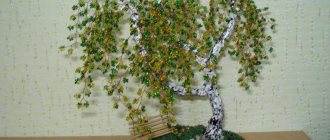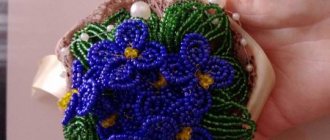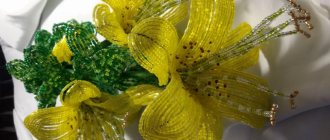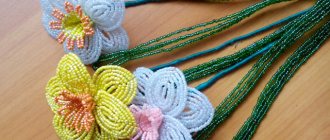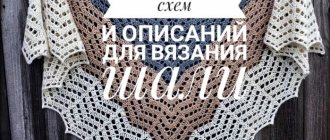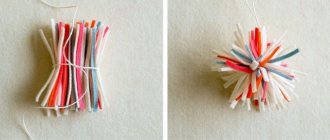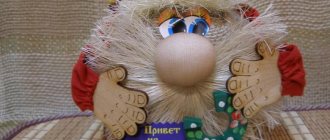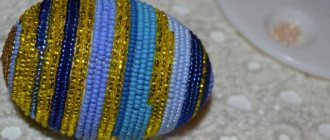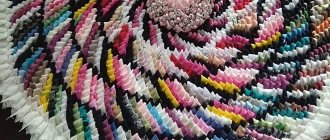Selection of materials and hook
Beads differ in manufacturers, sizes, shapes and colors. The best strands are made from round beads. In addition, this form is ideal for beginner craftswomen. The beads lie smoothly, and the product looks neat.
To determine the size of the beads, you need to remember that the smaller the number in the number, the larger it is.
For the first works, it is better to stop at size 8/0. It is not difficult to work with, and the decoration will look attractive. Experienced needlewomen choose sizes 10/0, 11/0 for plaits.
Beads made in Japan and the Czech Republic are suitable for jewelry. It is smooth and has a large color palette. The best option from a price-quality point of view is Czech Preciosa or Gamma beads. Japanese Toho and Miyuki are also suitable for knitting, but this is a more expensive option. Chinese beads are attractive in price, but poorly calibrated, so they are not recommended for work.
When choosing colors, you should keep in mind that the color of the beads in the bag may often not coincide at all with how it will look on the thread. This especially applies to transparent beads or those with a painted center. In the package it looks much darker than it actually is.
At first, it is recommended to use opaque beads with a matte, shiny or pearlescent surface.
Crochet bead strands (patterns can be simple or complex) are structurally different in the diameter of the cord and are divided into types:
| Types of harness | Number of beads in diameter, pcs. |
| Thick | 15-20 |
| Average | 8-10 |
| Thin | 4-6 |
Thin products are usually made long and made in one color or in a scattering of colors. For example, lariats are neck jewelry where the cord does not close into a circle. This allows you to get creative while wearing it, tying it in different ways.
Thick strands are painstaking work that requires professionalism and patience from the master. Such jewelry is distinguished by the complexity of the pattern, multi-color and detailed pattern. The most common type of tourniquet is medium. The average number of colors in them is 2-3.
There are most of these patterns on the Internet, and it is these that it is advisable for beginning needlewomen to learn from. Those who have taken up bead knitting for the first time are not recommended to use 1 color of beads in their work, as the rows will merge, which increases the likelihood of errors. Ideal to knit with 2 or 3 colors in contrasting colors.
The following threads are used to make bundles:
- Iris.
- Snowflake.
- Canarias.
- Violet.
- Monofilament.
Any sewing thread in a spool will also work. If they are too thin, then you can knit in several folds. The ideal option is when the color of the thread matches the main color of the beads.
But many people do not adhere to this rule, since a translucent contrasting thread can create interesting color effects. For beginners, it is better to choose light threads, for example, white or beige, since the loops on them are better visible and easier to knit.
The needle has an important function, since the right needle will greatly reduce the time when threading beads onto a thread. With the help of a long 10-centimeter needle, beads can be easily placed on a thread if the knitting is one color or a multi-colored scattering, when there is no need to follow the pattern.
If the beads are assembled according to a pattern, which means one piece at a time, then it will be inconvenient to work with a needle longer than 6 cm. Crochet bead strands, the diagrams of which are presented in the article, are crocheted No. 0.8 – 1. The size of this tool depends on the preferences of the needlewoman, the density of knitting, the thickness of the thread and the size of the beads.
Often the need to change the hook size is visible already at the beginning of the work, when there are large gaps between the beads, or, conversely, they are pressed too tightly against each other.
Instructions for making a spiral
To learn how to make a beaded spiral, I suggest you read the detailed illustrated instructions.
1. Cut a piece of fishing line and string a cap bead onto it, carefully tying the knot.
2. Then we continue to work, following the diagram and illustrated description.
3. We make a set of three pairs, consisting of two beads and bugles. We lower all the typed elements to the stub.
4. Insert a needle into the first two collected beads, closing the circle.
5. For convenience, you can use a pencil of suitable diameter.
6. We collect 2 beads and 1 glass bead, and use the needle to pass through the second bead of the previous tier. See photo illustration.
7. The process is repeated until the end of this row. All subsequent rows are formed using the described technique, moving in a spiral.
8. We form the product of the required length.
9. Cut off the excess fishing line and burn it with a lighter. We put the finished cord on the workpiece.
10. As a result of creative work we get an unusual decoration.
Having learned how to weave a variety of beaded cords, you can create any desired jewelry.
Master class on how to crochet a simple rope of beads
For beginning needlewomen, making a rope should be as easy and understandable as possible, so you should choose 2 colors of beads that contrast with each other. Size – 8/0.
Other required materials:
- Iris threads,
- hook,
- scissors,
- needle,
- clip.
Stages of work:
- First of all, you need to calculate the required number of beads and the length of the thread. To do this, you need to decide on the length of the rope and the number of beads in its diameter.
For the master class, a tourniquet 7 cm long was chosen, having 7 pieces. beads in diameter. This diameter will correspond to 10 mm. Therefore, the final length of the thread is:
7 cm * 7 pcs. = 49 cm.
- Next, you need to add 49 cm of beads onto the thread. The pattern is as simple as possible - alternating green and white rows. This means that you should select beads alternately: 7 green, then 7 white, then green again, then white.
Before casting on, it is advisable to measure 49 cm of thread and secure it to the ball with a paper clip. This will allow you to make a neat bead thread.
After casting, you need to remove the paperclip, additionally measure about 0.5 m of thread and secure it with a paperclip again, and move the beads closer to the skein, leaving only 10 or 15 beads at the beginning of the thread for knitting the first rows. As you knit, you will always need to hold about 15 beads in your palm.
- The tourniquet in this master class is made in half columns. The row begins with an air loop. When knitting the second loop, you should grab 1 bead and knit it. The remaining green beads are also knitted.
The result should be a chain of 7 beads. After this, the chain must be closed into a ring. If everything is done correctly, the beads will be on the outside of the ring, and the thread base will be on the inside.
- For the second row, 7 white beads must be “prepared” in the palm. They need to be knitted in half columns.
To do this, insert the hook from the wrong side under the green bead, push one white bead with your finger and grab the thread behind it, pull the thread first under the beads of the first row, and then through the loop on the hook. Thus, there should be 1 loop left on the hook.
The remaining loops of the row should be knitted in the same way, making sure that the wrong side consists only of threads, and the face is made of beads. It is also important to control the thread tension. If the tension is incorrect, the beads will either fall out of the total mass or, on the contrary, fall inside the strand.
- The third and subsequent rows are knitted in accordance with the description of the second row. You should try to lay the beads evenly one above the other. In this case, in the process of knitting a row, the beads will be positioned vertically, and in already knitted rows - horizontally. The quality of the finished work depends on attention to these details.
- After reaching the required length of the rope (7 cm), you need to knit the last row with half-columns, but without beads. This is done so that the beads in the penultimate row are “laid” horizontally.
Next, the thread is tightened and cut. And the product, depending on its purpose, is decorated with the necessary fittings. In the process of working on simple patterns, and even more so on complex ones, errors may be made related to counting beads.
Below are ways to fix them:
- Removing beads from a chain. This situation can arise if there is a mistake in color while casting according to the pattern, or if in the middle of knitting it turns out that the bead is uneven or of poor quality.
- You can remove unnecessary beads by crushing them with pliers, and in order not to accidentally touch or cut the thread, you should first insert a needle into the bead.
- Add the missing bead. If the beads were missed or removed due to an erroneous set, then the desired bead should simply be sewn onto the finished strand. To do this, in the place where it will be sewn, you need to knit a loop without beads, thus leaving free space.
Step-by-step knitting of a rope with your own hands
The first part of the harness is plain. You will need size 10 beads in the primary color. First they close in a ring - this is the first row. The second and subsequent rows are formed by weaving beads one at a time into the previous row.
The second part is spiral. It turns out this way due to the difference in the size of the beads. The principle of operation is the same: string the beads one by one into the workpiece in a circle. Only now you need to monitor the alternation of colors.
When the second (central) part is of the desired length, it remains to weave the third. Again, one primary color is involved in the work. It is important to make the final piece the same length as the first.
When the weaving is finished, you need to attach the clasp. The tourniquet is ready.
Single crochet harness
To make a spotted rope in red you will need:
- beads No. 10 – 4 colors,
- thread,
Crochet bead strands: single crochet weaving patterns
- hook 0.75 mm thick,
- needle,
- scheme,
- accessories for the finished product (clasp, rings, caps, pins, large beads).
Harness diagram:
- The diagram shows rapport (repeating pattern). The number of repeats will depend on the intended length of the harness.
- This spotted cord should be 39 cm long. According to the diagram, this corresponds to 7 repeats. One row – 25 beads.
Stages of work:
- It is necessary to string beads onto a thread, taking into account the pattern and number of repeats.
- You should start knitting by knitting a chain with air loops. Total - 25 loops.
- The first 3 rows must be knitted without beads. Subsequently, they will be needed to secure the harness to the fittings. The 2nd and 3rd rows should be knitted with single crochets.
- Next, you need to complete a row, knitting beads in single crochets. To do this, move the beads close to the hook and loop, grab the thread with the hook through the loop of the bottom row and pull it through. In this case, the bead will already be fixed. The two loops formed on the hook should be knitted.
- In the same way, you need to perform the remaining loops of the row. The 25th bead will end the row. Moreover, it should not be above the 1st bead, but next to it.
- Work should continue according to the scheme until the length of the tourniquet becomes 39 cm.
- The last 2 rows need to be knitted in single crochets without beads and at the end fasten and cut the thread.
In order for the harness to turn into a stylish decoration, the necessary accessories should be attached to it:
- It is necessary to process the edges of the tourniquet. To do this, place a pin in the bead and carefully sew up the ends.
- Then you need to put the fastening cap on the pin. Part of the wire must be removed using wire cutters, leaving a tip sufficient to round it into a ring.
- Lastly, the lock should be secured to the harness.
Description of work
You can knit strands of beads using a half-cable or a single crochet. Many needlewomen believe that crocheting with beads in a column is more perfect, since the pattern is clearer and the threads are not visible on it. The beads lie flat and tight in a column.
We suggest going through a small tutorial “Bead Harness” in each technique. Try and choose the most convenient way of knitting a rope for yourself and use only it.
Column
Many beginners do not know how to knit a beaded rope correctly. The knitted rope of beads turns out elegant and thin. For knitting with beads, hook 1 is used; some needlewomen use even thinner hooks - 0.9 or 0.7.
How to tie a string of beads in a column will be described below:
- Cast on air loops and close them in a circle with a connecting loop.
- Insert a hook into a nearby air loop from the circle (it already produces two loops). Pass the thread through one loop with the hook, two loops will form back on the hook. And now you crochet the thread for the second time through these loops.
- Now we knit with beads. The bead moves close to the hook when you skip the first loop.
It takes a little longer to knit a string of beads in a column compared to the half-column technique due to the fact that the needlewoman has to knit more loops. However, this allows you to weave thick strands starting from 10 beads in a circle.
Half-column
To understand how to crochet a rope from beads, you can use a technique called a half-column. Crocheting a rope of beads in a half-stack is done with only up to 10 beads in a circle. This type of crochet with beads always turns out delicate and graceful. If you have already worked in the column technique, you will understand exactly how to crochet a rope of beads using a half column. This is due to the fact that in the stitch technique it is necessary to pass the thread through two loops twice, but when weaving with a half-column this happens only once. In a half-stitch, you simply insert your hook into an adjacent stitch on the bottom row and bring out one new stitch.
When crocheting a rope of beads correctly according to our master class, only the beads should be visible in the product, the thread itself remains inside the product.
Single crochet
Many beginners do not know how to weave a rope of beads using single crochet crochet. Such needlewomen believe that single crochet crocheting is another additional method of beading. However, if you see cable knitting patterns that indicate single crochet, this means beading with a regular stitch.
Tourniquet in a column
Crochet strands of beads (patterns are shown using crochet and half-stitch crochet) differ not only in the technique of execution, but also visually.
For example, this is expressed in the tilt of the beads on the finished strand. The column is characterized by a diagonal arrangement. When knitting in a half-stitch, the beads lie horizontally.
List of tools
Before weaving a beaded cord, you need to prepare tools and materials. You will need:
- beads of the desired size and color;
- glass beads (for a spiral strand);
- long bead needle;
- threads for knitting lace;
- accessories for jewelry (callots, hugger, lobster clasp);
- scissors.
scissors beads threads for lace knitting lobster clasp callots
hugger
A lighter for melting the thread and a towel, preferably linen, will also come in handy. On such a base it is worth pouring bunches of beads of each color. This way they are clearly visible and will “jump” less on the surface. To make a knitted version of the cord, you will additionally need a crochet hook and thread.
Beaded monochromatic rope
Crocheted strands of beads of the same color do not require the use of a pattern, so there is less chance of getting confused and making mistakes during work. To make such strands, you should take a thread that matches the color of the beads. The circumference of the product is usually medium or thin, so the best knitting option is to use half-stitches.
Single-color strands can be used to make bracelets and necklaces, but more often they are used to make lariats.
The difficulty in working on a lariat is that it is usually long (up to 1.5 m), so you need to string a large number of beads. It is difficult to move meters of beads along the thread during work.
Experienced craftswomen recommend placing the beads evenly on the thread and only then twisting it into a ball. In this case, you will not have to move large volumes of beads over long distances. Another problem is that a long knitted cable gets twisted and interferes with further work.
There are two ways out of this situation:
- Tie the tied end into a knot. In this case, after untying there is a risk of creases appearing.
- Periodically unwind the tourniquet in the opposite direction. This is less convenient, but there is no risk of deforming the product.
Harness in American technology
This product has a simple technique, so even a beginner can weave such a rope.
Materials and tools
You will need:
- beads;
- beads;
- strong thread or fishing line;
- bead needle.
Operating procedure
Using a similar technique, you can make a rope of beads and beads or a multi-color necklace from beads of the same size. Most often, a two-color cord is woven.
1 bead is strung on a thread. To secure it to the thread, thread the needle through it a second time. This is the basic element; 4 beads are added to it on a thread.
String 3 beads, pull the thread through the holes of the last 4 beads.
String 1 bead and 3 beads again.
The first one is moved close to the woven element, the needle is inserted into holes 3 to 6 of the beads.
Further steps are to attach 4 elements to this base: 1 bead, 3 beads.
Important! When weaving, the needle is passed through the main beads, otherwise the product will have distortions.
Using this technique, the decoration blank is increased to the required length.
All that remains is to securely fasten the thread, install the accessories, and the American bead strand is ready.
Patterned strand of beads
The plaits can have either simple patterns alternating 2-3 colors or complex ones. To make such decorations, you need to be able to read pattern diagrams. There are several programs in which you can make patterns yourself, count beads and threads. They all make similar designs. Therefore, as an example we can cite, for example, the DB-Bead program.
This diagram allows you to see (from left to right):
- The first drawing is the author's design, from which the program generates a diagram.
- Next comes the diagram itself, which you need to focus on when knitting. This is an unfolded tourniquet.
- The following picture shows what the harness will look like when finished.
- The colored squares in all 3 pictures are a pattern. This pattern shows that the pattern needs to be repeated every 20 rows.
Patterned crocheted bead strands: diagrams
- In the upper right corner the necessary numerical information is indicated: the number of beads in a row (7 pcs.), the number of beads in a pattern (140 pcs.), the number of rows (20).
- The multi-colored columns below are the order in which colored beads are placed on a thread. You should start the set from the top left square and move down, then move to the column to the right.
Calculation of beads for the product
How to decide on the number of beads that need to be strung on a thread before starting knitting? For example, a bracelet made of beads will be much shorter than a necklace, and therefore less material will be required.
To calculate, use a simple formula:
A*B = C, where A is the desired length in cm, B is the number of beads in the bundle, and C is the length of the thread in cm on which the beads are strung.
So, to get a strand 45 cm long, you need to fill a section of thread 540 cm long (45*12=540) with beads.
Bead strand in half-columns and columns
Sometimes the insufficiently neat appearance of the plait is associated with the wrong choice of the type of knitting (stitch or half-stitch). Beginners, in order not to make mistakes, should strictly follow the diagram and description of the manufacture of the tourniquet.
Experienced craftswomen can already take into account several factors to choose the right type of knitting, such as the diameter of the rope, the size of the beads and thread. Stitch knitting is used on strands of thick diameter and allows you to make complex patterns.
When choosing stitch knitting on small diameters, there will be a large space left between the beads, which, of course, should not be allowed. In this example, both strands are connected with the same threads and beads and have the same diameter, consisting of 10 beads. But the upper sample is made with half-columns, and the lower one with columns.
If you are in doubt about how to knit a product, it is recommended to make a small sample up to 5 cm long before starting work.
How to read a diagram correctly
Schemes for different shapes of the harness are compiled using a special program using a computer.
The columns have their own purpose:
- “Design” - determines the drawing of the diagram;
- “Unfolded”—shows the view of the tourniquet in an unfolded form;
- “Harness”—displays the appearance of the resulting harness.
By checking with them, you will be able to not deviate from your plan and follow the drawing.
The rows are located to the right of the columns:
- "Set" reflects the name of the circuit in question;
- “Circle” is the number of beads located in each row;
- “Repetition of color” provides information about the beads and their number in one repeat;
- "Rapport" is a diagram of how to string beads onto a thread to create a pattern. It can be presented in several columns to obtain complex weaving. In this case, the columns are read from top to bottom, starting with the leftmost one.
The presented scheme is simple and consists of two colors. For more complex patterns, it is worth practicing on a small segment.
Half-column bead strand
As the level of skill in knitting ropes increases, there is a desire to master new techniques and original effects in order to make more interesting products. One such useful skill is increasing and decreasing the diameter of the cord.
The increase is performed by knitting two loops in one loop of the previous row. In this case, the hook should be passed under the two threads of the bottom loop. Both half columns must be made with beads.
When decreasing, two loops of the previous row need to be knitted with one half-column with a bead. If the pattern is simple and the expansion is small, then it is enough to ensure that the added and decreased loops are symmetrical.
In other cases, in order not to make a mistake, it is recommended to mark on the thread with beads attached the places where there will be contraction or expansion. This can be done using small pieces of paper.
Square type
If you make it a rule to follow the step-by-step instructions for knitting a rope with your own hands, then at the final stage you can get a magnificent decoration, and mistakes will be kept to a minimum.
- No less useful are detailed diagrams that should be placed in front of you and, if necessary, look into them to clarify further actions.
- Square weaving is considered one of the more complex execution options, so at each stage it is necessary to show maximum care and concentrate on the process.
The technique is used to create a base for a necklace or bracelets; if we take into account the classic weaving, then everything looks like a pile of cubes, each of which has its own base and shape.
Embroidery of a strand of beads on a rope - African technique
Crochet bead strands, patterns for which today can be easily found in any variations, require craftswomen to know the basics of knitting. The African method of making jewelry is easier to make, but the result is also impressive.
The essence of the technique is to tightly stitch beads onto a regular cord or thick rope using a needle.
Unlike previous works, here there is no need to first place the beads on the thread according to the pattern, which means there is less chance of error.
To make a necklace you need:
- beads,
- rope,
- thread or fishing line,
- needle,
- accessories for jewelry.
An important nuance is the choice of rope. Preferably the diameter is between 5 and 8 mm. A smaller diameter will complicate the work and a gap will be visible between the beads. A larger diameter is suitable for those who love massive jewelry.
In terms of material, it is better to choose a cord that has a cotton braid. It is easier to embroider with this braid – the beads lie more evenly. In addition, upon completion of the work there will be no difficulties in securing the ends and fittings.
Stages of work:
- First of all, you should secure the thread on the cord in any convenient way. Next, beads are strung on a thread. This can be several beads or a chain of beads that will make several turns around the rope. It must be remembered that the fewer beads are sewn at a time, the better the quality of the work will look.
- The bead chain should be wrapped tightly around the rope. To secure the chain, you need to grab it in several places with thread. To do this, the needle is stuck into the cord and removed through the last few beads. Then you need to make a cross stitch, thus sewing the thread to the braid.
This fastening must be repeated along the entire length of the sewn chain from end to beginning.
- After the wrapping is sewn, you should return to the place where the work stopped, namely, first bring the needle a couple of beads to the end. And then pass the needle through these beads, sewing them to the braid.
- Next, you need to continue embroidering along the rope, alternating between setting beads on a thread and securing the resulting chain of beads to the surface of the cord.
- After the harness has reached the required length, the work must be completed. To do this, the core of the rope needs to be cut 1-2 cm from both ends of the bundle. Tuck the braid into the resulting void and tighten the end with thread. The tourniquet is ready. All that remains is to fasten the clasp on it
History and relevance of knitting with beads
Crochet was born at the beginning of the 19th century, and the addition of beads or beads to the thread began almost 200 years ago.
This technique was first used by German craftswomen after the end of the Napoleonic wars. Over time, art came to Russia and was used to decorate napkins, pincushions, Easter eggs, pouches, and paintings. Beads in knitwear are mainly associated with the retro style that made this technique popular. For some time they forgot about knitting with beads and bugles, but today it has begun to revive again. Many needlewomen have already mastered this technique, so can you!
A product made using this technique looks organic and decorative and does not require additional finishing. Threads and beads are inexpensive, while the result of the work pays for the investment of time and money.
You can knit something small, for example, a cosmetic bag or a case for glasses. This technique is also suitable for decorating armholes or sleeves of knitted items; it is not at all necessary to use it throughout the entire work.
Toys and keychains decorated with beads will not leave anyone indifferent, and clutches and wallets look expensive and noble. Unlike beads sewn on top of a knitted product, this technique eliminates the risk that the thread will break and your efforts will go down the drain, while all the beads will lie perfectly even.
Other patterns for weaving strands of beads
Among other popular models of knitted harnesses, you can o.
Knitting should be done as for a regular braid, but to get “fur” between the loops you need to knit a long loop. Any number of beads or beads are strung on this loop. Everything is limited only by the imagination of the needlewoman.
A wide variety of patterns among strands braided with a needle:
- "Mosaic".
- "Square".
A strand of beads is a modern and original decoration, created by the skilled hands of a craftswoman, as well as with a crochet hook or a needle. You can create harness diagrams in special programs, or work with ready-made diagrams that needlewomen share on the Internet.
Author: Vorobyova Nadezhda
Article design: Natalie Podolskaya
What materials to choose for weaving
The main requirements in the needlework process are the correct choice of the base on which the transparent beads will be held.
For this you will need:
- Monofilament. It is a thin and soft fishing line, the volume of which does not exceed 0.10 mm;
- Fishing line. This type of synthetic base is used for fishing. To work with beads, it is recommended to use thin but durable models of the product;
- Reinforced threads. They are cotton threads containing synthetic fibers. They provide the material with additional strength and durability during product operation.
Solving all issues
All questions will be resolved if a universal answer is found. What to put on your neck or wrist, what to use as a belt, what to hook onto your bag as decoration. A similar solution could be a lariat - a long universal tourniquet.
Finally, don't use hooks or clasps, but use large rings for your keychains so you can put the clasps on them.
Meanings for girls
Girls certainly care about how they look when walking, working, or celebrating. An integral part of the appearance are various decorations. Jewelry made from expensive metal is very expensive due to difficult-to-obtain materials and painstaking work. Therefore, it is worth taking a closer look at the beautiful jewelry.
It’s easy to buy ready-made bracelets, earrings and necklaces made from scrap materials. Before buying, you should think about it: the product took a small amount of time, effort and materials from the manufacturer.
It was not made using such complex techniques that you would not be able to make a bracelet yourself. Why overpay for someone else's wasted time if you have the opportunity to spend your time usefully and make interesting earrings yourself.
How to finish a product
Secure the base. Thread - tie knots. Burn the fishing line with fire so that it melts a little and takes on a closed appearance. Simply roll the wire obliquely and cut it off, or tie it in knots. Attach jewelry fasteners and secure hooks.
Secure the hooks without fasteners, and the product will seem of poor quality.
Earrings require hooks.
Use an original method of fastening, this is to use quickly hardening materials. For example epoxy resin. It is enough to apply one drop to the places of fastening and dry under a UV lamp.
